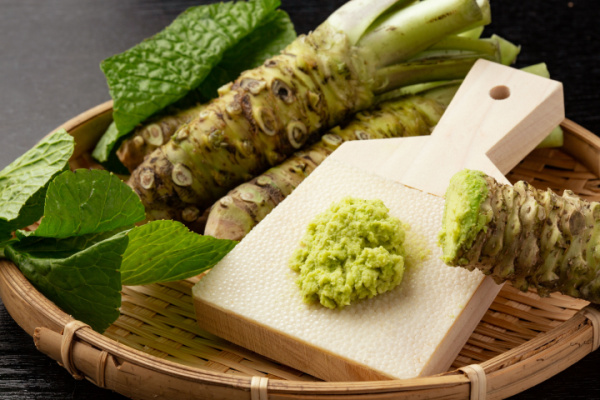If you are a fan of Japanese food, chances are you’ve seen wasabi served up as a pale green paste to be paired with pieces of nigiri sushi or slices of sashimi. It’s distinctly green, zingy, and you either love it or you hate it, but have you actually eaten the real thing?
If you think you’ve tried wasabi before, the chances are that in fact, you haven’t! Many people who have only eaten “wasabi” outside of Japan have probably only had imitation or fake wasabi.
According to the website byFood, Japanese, hon-wasabi refers to the wasabi plant that is native to Japan, while seiyo-wasabi is the word for horseradish which is from Europe (sometimes also called wasabi-daikon). Japanese native wasabi is the real deal, but being cheaper, European horseradish is used to create powdered fake “wasabi” and other faux wasabi products. Using a low percentage of real wasabi, seiyo-wasabi is dyed green to make fake wasabi as a cheaper alternative.
Also known as “Japanese horseradish”, real wasabi comes from a plant that belongs to the Brassicaceae family, which typically encompasses other types of radishes, horseradishes, and mustard plants. More like a root vegetable than a spice, real wasabi is made from the rhizome of a wasabi plant, which is the underground stem part of it. This underground stem is grated finely to create real wasabi paste. This is kind of like how ginger can be grated, although wasabi is a bit less fibrous.
Trying real wasabi outside of Japan can be difficult—it’s hard to find and very expensive. Why? Real wasabi is incredibly expensive because wasabi plants are notoriously difficult to grow and require very specific conditions. In Japan, the wasabi plant grows naturally in areas that have mountain river valleys, where it can grow along the river stream beds. This is why a lot of people outside of Japan may have never actually tasted real wasabi before.
If you’re wondering what fake wasabi is made of, it’s mostly regular seiyo-wasabi (horseradish) in disguise. To make this condiment cheaper and more accessible, many fake wasabi products are widely available in supermarkets or at your local Japanese food restaurant, made from European horseradish.
Imitation wasabi can be found in a paste form (often in a squeezable tube or a small packet) or powder form (this needs to be mixed with water, generally in a little tin). Generally speaking, these fake wasabi products will only have a tiny amount of real wasabi in them, around just 1 to 3 percent. This small amount of hon-wasabi is mixed with colored European horseradish instead to make it more affordable.
What does the real thing taste like? Distinctly pungent in flavor, real wasabi has a similar taste to hot mustard in that its spiciness hits the nose rather than the tongue like a chili pepper does. True freshly-grated wasabi has a signature “clean” spiciness that is gentle to start but gives a touch of quickly fading heat in your nostrils. Compared with real wasabi, fake wasabi can be hot and zingy too, but not as clean in the mouth.
If you are wondering how to tell the difference between real and fake wasabi, first check the texture of the wasabi paste. When the wasabi is thick and pasty, that is a sign that it is fake wasabi made from horseradish (pureed to give a completely smooth texture). If the consistency is gritty (from being freshly grated), then it is more likely to be true wasabi from a wasabi plant stem.
Real wasabi is always served fresh because it loses its flavor and zinginess quickly once grated. For example, at a high-end sushi restaurant, the chefs will carefully grate the exact amount of wasabi to complement the sushi and balance the flavor of the fish. It is often placed in between the rice and the nigiri sushi topping to preserve it as best as possible.
—
Photo Credit: sasazawa / Shutterstock.com
